OSIRIS-REx Mission: NASA Finally Removed Stucked Fasteners and Access Asteroid Bennu Sample [UPDATES]
24th Oct 2023![OSIRIS-REx Mission: NASA Finally Removed Stucked Fasteners and Access Asteroid Bennu Sample [UPDATES] OSIRIS-REx Mission: NASA Finally Removed Stucked Fasteners and Access Asteroid Bennu Sample [UPDATES]](https://orbitaltoday.com/wp-content/uploads/2023/10/nasa-osiris-res-mission-team.jpeg)
For the first time in its history, NASA has landed a capsule with asteroid samples. What’s inside? Follow all of the latest OSIRIS-REx Mission updates with Orbital Today.
UPDATE: 12th January
The team responsible for curation at NASA’s Johnson Space Center in Houston has effectively extracted the two fasteners from the sampler head, NASA says. The fasteners were previously hindering access to the remaining sample material from the asteroid Bennu collected by OSIRIS-REx.
Currently, efforts are in progress to fully disassemble the Touch-and-Go Sample Acquisition Mechanism (TAGSAM) head, exposing the additional rocks and dust obtained through NASA’s inaugural asteroid sample return mission.
“Our engineers and scientists have worked tirelessly behind the scenes for months to not only process the more than 70 grams of material we were able to access previously, but also design, develop, and test new tools that allowed us to move past this hurdle,” said Eileen Stansbery, division chief for ARES (Astromaterials Research and Exploration Science) at Johnson. “The innovation and dedication of this team has been remarkable. We are all excited to see the remaining treasure OSIRIS-REx holds.”
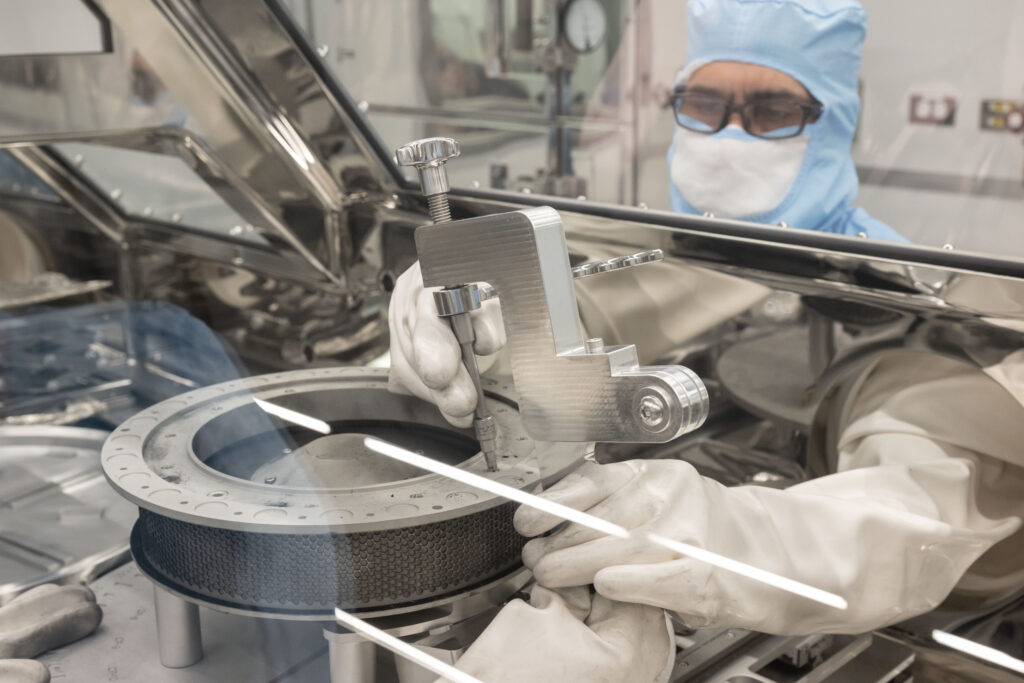
After a few more disassembly steps, the entirety of the bulk sample will be completely visible, according to NASA. At this stage, experts in imaging will capture ultra-high-resolution pictures of the sample while it remains within the TAGSAM head. Subsequently, this section of the sample will be extracted, weighed, and the team will ascertain the overall mass of the Bennu material collected during the mission.
UPDATE: 24th October
About a month ago, pristine asteroid samples arrived on Earth, enclosed within a secure capsule. However, NASA’s Johnson Space Center is facing challenges in opening the capsule to access these samples. The primary issue is with the TAGSAM head, which contains the majority of the asteroid material. Two fasteners on the TAGSAM head cannot be removed with current tools, necessitating the development of new methods to access the material while preserving its integrity.
When the sample canister’s lid was first opened, it revealed dust and debris on the avionics deck. While some material has been extracted from the canister, the curation team is working on ways to access the rest without compromising scientific standards.
Despite these challenges, the mission has already exceeded its goal by collecting 70.3 grams of asteroid debris. Initial analysis shows the presence of carbon and water molecules, supporting the theory of organic matter within these ancient space rocks.
UPDATE: 11th October
The first analysis showed that Bennu samples contain carbon and water.
“Carbon and water molecules are exactly the kinds of material that we wanted to find. They’re crucial elements in the formation of our own planet,” says NASA Administrator Bill Nelson.
“The OSIRIS-REx sample is the biggest carbon-rich asteroid sample ever delivered to Earth and will help scientists investigate the origins of life on our own planet for generations to come.”


The carbon content of the Bennu sample is 4.7%, the highest carbon abundance ever measured in a sample returned to Earth.
Principal Investigator Dante Lauretta: “We’re looking at the kinds of minerals that may have played essential roles in the origin of life on Earth.”
“They have water locked inside their crystal structure,” says Dante Lauretta, OSIRIS-REx PI. “The reason that Earth is a habitable world… is because these clay minerals… landed on Earth 4-4.5 billion years ago.”
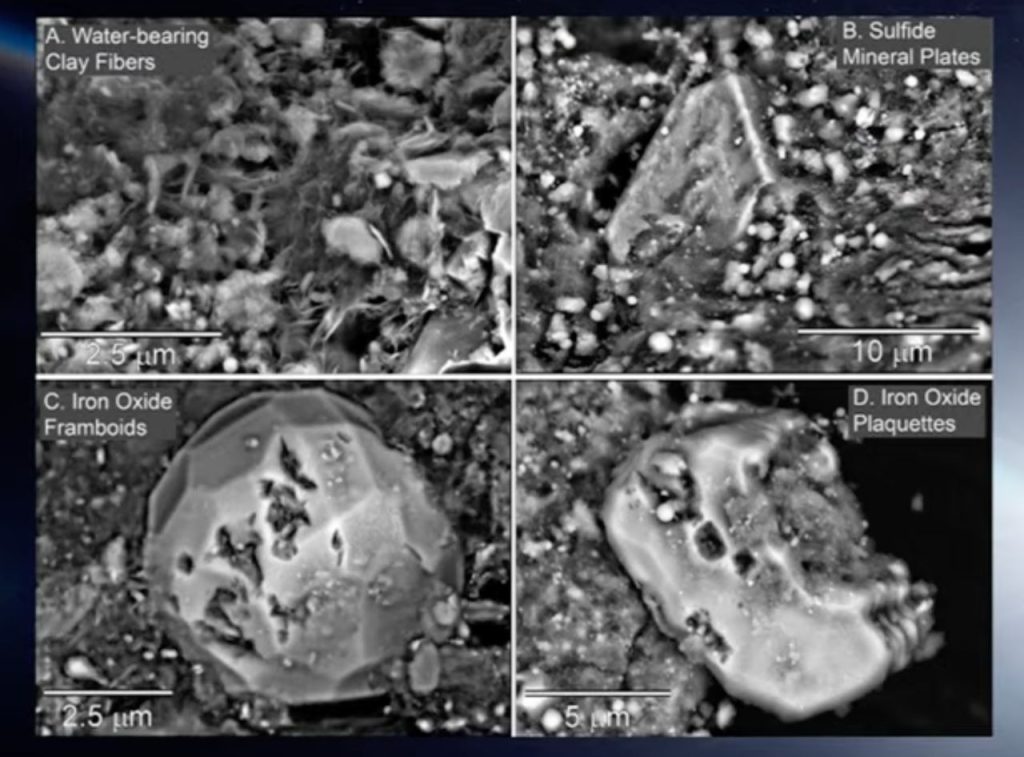
The goal of the OSIRIS-REx sample collection was 60 grams of asteroid material, NASA says in a live stream conference that it managed to collect and deliver 8.8 ounces (250 gm) of material.
How to watch the revealing of NASA’s OSIRIS-REx asteroid sample?
Do you want to look at the images of the bulk sample and early analysis results? NASA plans to unveil images of the bulk sample and early analysis results during a live event on October 11th at 11 a.m. EDT, promising a fascinating glimpse into our celestial neighbour.
UPDATE: 9th October
As NASA’s OSIRIS-REx mission is inching closer to unveiling the secrets hidden within the asteroid Bennu, exciting developments are unfolding. The astromaterials curation team at NASA’s Johnson Space Center has been diligently working to gather the precious particles from Bennu, which were found outside the mission’s TAGSAM (Touch-and-Go Sample Acquisition Mechanism) head. In a recent milestone, scientists removed 14 circular witness plates from the top of the TAGSAM head, previously used to monitor the spacecraft’s interior conditions during the mission. These plates have been carefully preserved to gain insights into potential contamination.

Moreover, the team successfully detached the TAGSAM head from its avionics deck platform, affording them their first look at the 24 surface contact pads on the head and the asteroid sample beneath it. These contact pads captured fine-grained rocks and dust from Bennu’s surface when the sample collector made contact in October 2020, offering a unique glimpse into the conditions at the asteroid’s outer layer. The samples collected from the surface and the interior of the capture ring will provide invaluable data, shedding light on Bennu’s geologic history, impact events, and implications for asteroid impact assessments.
UPDATE 7 October
On 6th October, NASA announced that the OSIRIS-REx team would unveil the sample collected by the spacecraft from the asteroid Bennu on 11th October, with a broadcast starting at 16.00 BST (11.00 EDT).
UPDATE 3 October
NASA has just released a video captured by the OSIRIS-REx spacecraft, showcasing the moment the capsule containing samples from asteroid Bennu was detached. This separation occurred on September 24, 102,000 kilometers from Earth, as recorded by one of the spacecraft’s black-and-white navigation cameras. The video, meticulously processed by NASA, reveals intricate details of the capsule and the cloud of particles formed during its ejection, all while preventing overexposure of the crescent Earth in the frame.
Six hours after separation, the capsule re-entered Earth’s atmosphere and safely landed in Utah. It is now in a dedicated laboratory at the Johnson Space Center, where scientists have already begun examining its contents. NASA plans to broadcast the reveal of these precious samples to the world on October 11. Meanwhile, OSIRIS-REx embarks on its extended mission, setting its sights on the asteroid Apophis, which it will reach in April 2029.
UPDATE 29 September
NASA’s OSIRIS-REx mission’s sample curation from asteroid Bennu is proceeding more slowly than anticipated, but for a remarkable reason: there’s an overflow of material. When the science canister lid was opened recently, scientists discovered an abundant treasure trove of asteroid material inside and outside the TAGSAM head. This surplus has led to a methodical collection process. The first sample collected from the avionics deck is undergoing a quick-look analysis, employing techniques such as scanning electron microscopy, infrared measurements, and x-ray diffraction to gain comprehensive insights into Bennu’s composition.
UPDATE 27 September 1907 BTS
On 26 September, NASA scientists discovered black dust and debris on the avionics deck of the OSIRIS-REx science canister when they first opened it.
The Johnson Space Center is home to the world’s largest collection of space materials, and experts there will carefully take apart the Touch and Go Sample Acquisition Mechanism (TAGSAM) to reach the main sample inside.
“We opened up the canister today, and we did see that there is some black dust-like material that’s visible,” Lauretta said Tuesday. “We’re hoping that’s from Bennu. We expect that we’ll be collecting a portion of that tomorrow morning, and that’ll go right into laboratories.”
“This is our first glimpse of what we might have,” said Lauretta, the OSIRIS-REx mission’s principal investigator. “There’s good indication that we might have sample.”
hese actions are being carried out in a specialized laboratory built for the OSIRIS-REx mission. To safely remove the aluminium lid, scientists used a glovebox designed for handling this large piece of equipment.
UPDATE 25 September 2032 BST
The University of Manchester, England, UK, will get a piece of asteroid Bennu following the successful landing of the OSIRIS-REx capsule.
NASA’s Johnson Space Center will share 25% of the asteroid piece with a group of over 200 people from more than 35 places around the world. Among them are scientists from The University of Manchester’s Earth and Environmental Sciences Department. They will examine the asteroid piece for the next two years.
The UK scientists want to find out about the asteroid’s past, what it’s made of, and where it came from.
UPDATE 24 September 2021 BST
The capsule has been recovered and brought to a clean room. The OSIRIS-REx team will now prepare the capsule for transport to the Johnson Space Center in Houston, Texas.
“Touchdown for science!” said Jim Garvin, chief scientist of NASA’s Goddard Space Flight Center, from the landing site during a live broadcast. “For the first time in history, we brought goodies back home from this kind of object. This is so huge and we’re all breathing a big sigh of relief.”
The capsule, containing approximately 250 grams (8.8 ounces) of rocks and other materials from Bennu, carries vital clues to address some of the most profound inquiries in the field of science.
These materials hold the potential to unravel mysteries about the origins of life on Earth and the early phases of our solar system. The OSIRIS-REx capsule achieved staggering speeds, reaching up to 27,000 mph (43,450 km/h), and its heatshield endured temperatures as high as 5,300 degrees Fahrenheit (2,900 Celsius) during its descent through Earth’s atmosphere.
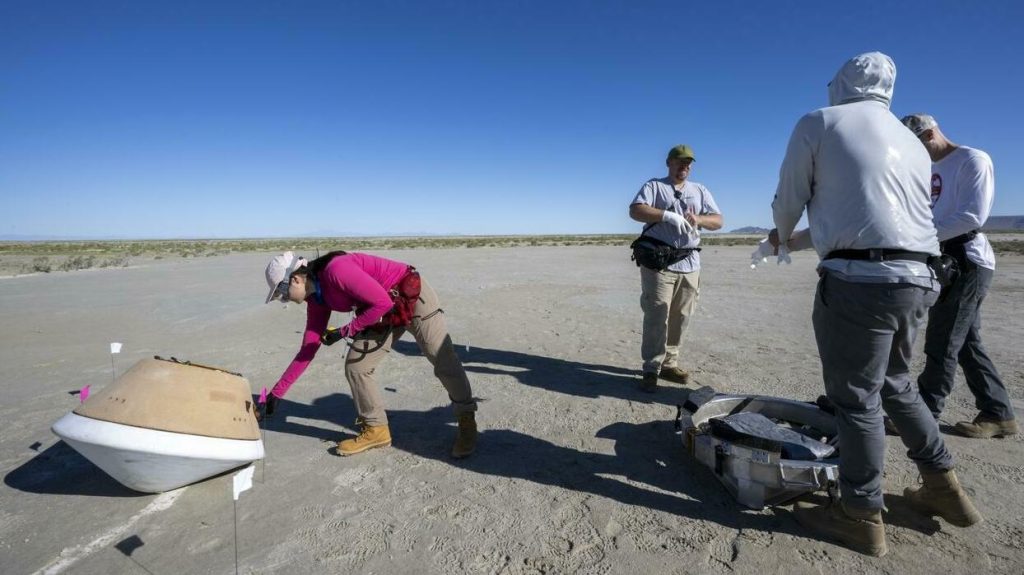
UPDATE 24 September 1128 BST
The OSIRIS-REx mission team has given the OK for the spacecraft to release the asteroid sample capsule during its fly-by of Earth.
Watch the return here: https://www.youtube.com/watch?v=Kdwyqctp908
UPDATE:
The OSIRIS-REx asteroid sample capsule will enter Earth’s atmosphere on 24th September at 10:42 a.m. EDT (15.42 BST), travelling at about 27,650 mph. NASA will provide live coverage of the capsule landing starting at 10 a.m. EDT (15.00 BST) on NASA TV, the NASA app, and their website. NASA will also livestream the Bennu samples’ return on YouTube.
A team led by NASA in Utah’s West Desert is getting ready for the first-ever U.S. asteroid sample to land on Earth later this month. With less than a month until the arrival, the OSIRIS-REx team is finishing rehearsals and is ready for the delivery. The OSIRIS-REx return date is 24th September 2023.
The final rehearsal went well
A mockup of NASA’s OSIRIS-REx (Origins, Spectral Interpretation, Resource Identification, and Security–Regolith Explorer) sample capsule was dropped from an aircraft on 30th August. It landed at the Department of Defense’s Utah Test and Training Range in the desert near Salt Lake City. This test was an important step before the actual capsule landing, carrying asteroid Bennu samples collected almost three years ago.
“We’re just a few weeks away from getting a piece of history from our solar system right here on Earth, and this successful test makes sure we’re prepared,” said Nicola Fox, a NASA administrator in Washington. “The pristine material from asteroid Bennu will help us understand how our solar system formed 4.5 billion years ago and maybe even how life on Earth began.”
NASA conducted various rehearsals before this drop test, including capsule recovery, spacecraft engineering, and sample curation procedures.
“I’m incredibly proud of our team’s hard work in this mission,” said Dante Lauretta, the lead investigator for OSIRIS-REx at the University of Arizona. “Just like our careful planning helped us collect a sample from Bennu, we’ve practised our skills for sample recovery.”
First-ever Bennu samples are going to Earth
The capsule is carrying about 8.8 ounces of rocky material collected from Bennu’s surface in 2020. Scientists will study these samples in the coming years to learn about how our planet and solar system formed and the origin of organic materials that might have led to life on Earth.
“We’re in the final stretch of this seven-year journey, and it feels like the last few miles of a marathon, with mixed feelings of pride, joy, and determination to finish strong,” said Rich Burns, the project manager for OSIRIS-REx at NASA’s Goddard Space Flight Center.
Where is the OSIRIS-REx now?
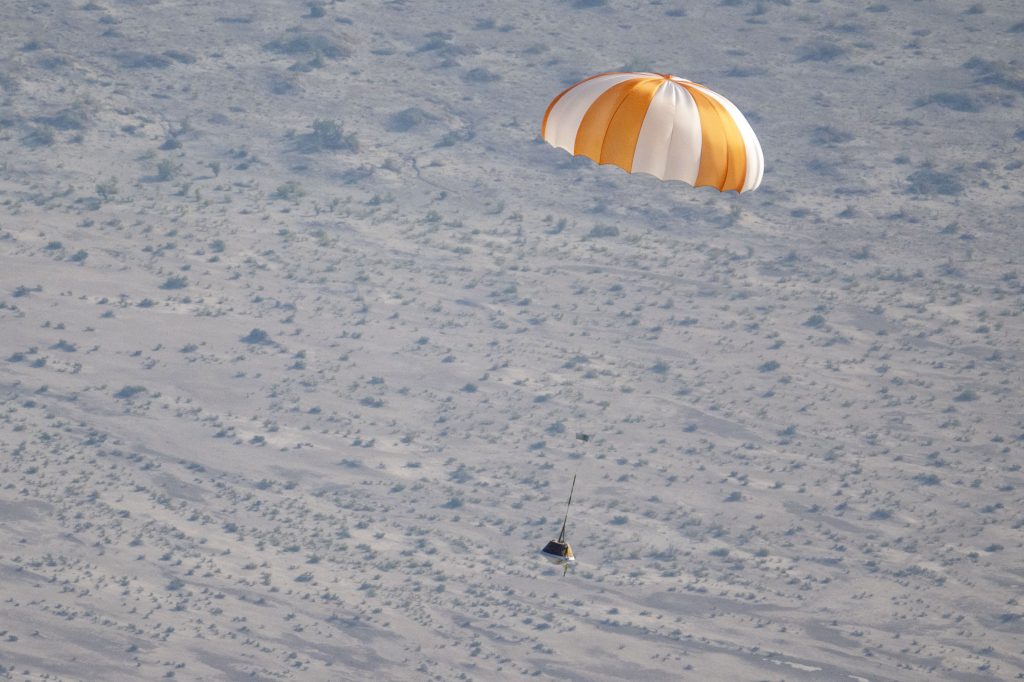
OSIRIS-REx mission delivery: what’s next?
Once the capsule is found and prepared for transport, it will be taken to a temporary clean room on the military range. There, it will undergo initial processing and disassembly before being flown by aircraft to NASA’s Johnson Space Center in Houston. At Johnson Space Center, the sample will be documented, cared for, and distributed for analysis to scientists worldwide. NASA’s Goddard Space Flight Center manages the mission overall, including systems engineering and safety. The University of Arizona in Tucson leads the science team and observation planning. Lockheed Martin Space built the spacecraft and manages its operations.
Goddard and KinetX Aerospace navigate the spacecraft. Sample curation, including processing upon arrival on Earth, is handled by NASA’s Johnson Space Center in Houston. The mission also involves international collaboration, with instruments from the Canadian Space Agency and sample science collaboration with Japan’s Hayabusa2 mission.
OSIRIS-REx is a significant mission within NASA’s New Frontiers Program, overseen by NASA’s Marshall Space Flight Center in Alabama.
OSIRIS-REx: All you need to know about the mission to Bennu asteroid
Our Solar System has lots of asteroids, comets, and small worlds. They are leftovers from the materials that made the planets long ago. Some of these celestial objects crashed into Earth a very long time ago. They brought water and chemical elements that started life here.
On Earth, things like weather and geologic processes changed the surface, so it’s hard to retrieve the oldest remains. But asteroids stay pretty much the same. By examining them, we can learn about how our Solar System was formed and what it was like when it was young.
Asteroids such as Bennu are really old. They might have carried water and other elements needed for life to Earth. Therefore, NASA sent the OSIRIS-REx spaceship into space in 2016. It is the first U.S. spacecraft to collect a sample from an asteroid and return it to Earth if everything goes well. It reached Bennu in 2018 and grabbed a sample in 2020. In 2021, it left Bennu and started its trip back to Earth. In September 2023, it will drop a capsule with Bennu’s stuff in the Utah desert.
The next stop is the Apophis asteroid
After giving us the samples, the OSIRIS-REx mission will go to an asteroid called Apophis. In 2029, Apophis will get closer to Earth than our geostationary satellites – at a distance of 30,600 kilometres (19,000 miles) from the Earth. OSIRIS-REx will study it for 18 months. It will have a new name, OSIRIS-APEX.
The whole OSIRIS-REx mission costs about $1.16 billion and takes 15 years.
How OSIRIS-REx works
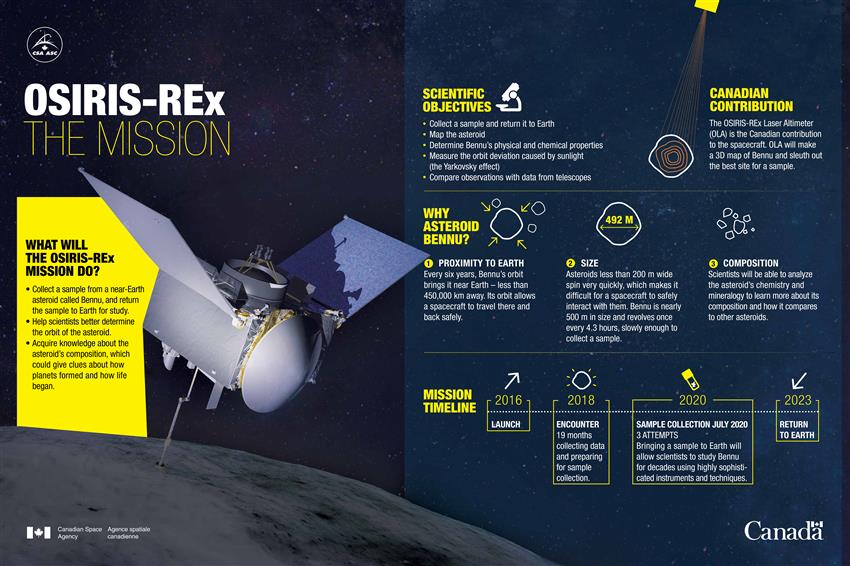
OSIRIS-REx is a big spaceship, like a van, and it weighs a lot (more than 2 metric tons, but half of that weight is fuel). It has a long arm to grab samples and solar panels that fold.
These panels helped it move near Bennu and protected it from debris that could have hit it. The spaceship has lots of tools to study an asteroid’s composition and map its surface.
When OSIRIS-REx got to Bennu, it found more rocks than expected. It took a long time to pick a safe spot to get a sample. In 2020, it used a TAGSAM device to high-five Bennu and collect samples with its arm. It worked so well that a flap on the sample collection chamber was jammed open by asteroid material.

What OSIRIS-REx can teach us about asteroid defence:
- Bennu is a near-Earth asteroid, meaning it gets close to us.
- Small asteroids like Bennu (which is just 500 meters (a third of a mile) across), can change their path because of heat and other factors we don’t know much about.
- These small changes can mean an asteroid hits Earth or misses. OSIRIS-REx will study one of these changes, called the Yarkovsky effect.
In 2013, The Planetary Society, the University of Arizona, and MIT held a naming contest to help name the asteroid OSIRIS-REx. It was called 1999RQ36 before. There was also an opportunity to send names on the spaceship through the Messages from Earth program.
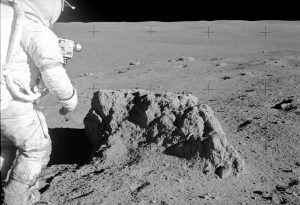
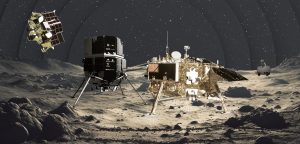




Thank you for your comment! It will be visible on the site after moderation.